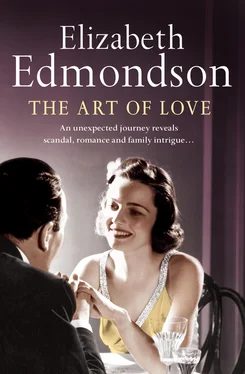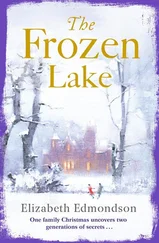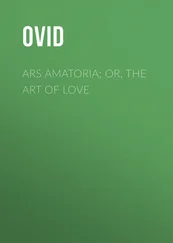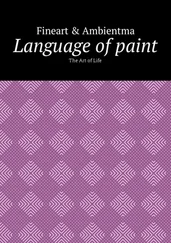The workshop was a lofty, barn-like-place, redolent of linseed oil and turps and oil paint. Situated above a storage area, it was reached via a rickety wooden outside staircase. Students were taken on to touch up and improve unsaleable old pictures and canvases that the gallery had bought in job lots at country sales, or for a few shillings in the minor London auction rooms.
The truth was, Polly soon realized, that there was an awful lot of dull and downright bad art around. Yet even the most dismal picture, by a hopeless artist, could be made to look much more desirable with careful, skilled work and a sense of what was in fashion.
Polly was started on flower paintings, which always, so her boss, Mr Padgett, told her, found a steady market. Dreary collections of tired-looking blooms in frames that were often worth more than the paintings arrived at the back of the Rossetti Gallery premises, and were taken, minus their frames, up to the workshop to be stacked in daunting ranks on wooden pallets all along one wall.
Mr Padgett, who was quick to weed out those workers he considered would never make the grade, had watched Polly for a few days, and then told her that she would do. ‘Unlike a lot of art students, you can paint. I don’t know what they teach you at these colleges these days,’ he grumbled. ‘Some of you don’t seem to know how to hold a brush or draw a curved line.’
‘Modern art isn’t about painting or drawing curves, Mr P, ’ retorted Sam Carter, a cheeky young student with a lock of hair falling over his forehead. ‘Times have changed, you’ve got to keep up. Anything is art now, if you say it is.’
‘Maybe to you it is, but it’s not to our customers, so just you hurry up and finish that landscape before those cows there die of old age.’
Sam, a student at the Academy, could draw or paint almost anything, and Polly envied him his facility. Under his skilful hands, landscapes bloomed, animals looked as though they belonged to a known species, ships sailed and fought as though they meant it, and faces changed from blurred ugliness to beauty, which was why, despite the avant-garde nature of his own work and his scorn for all old-fashioned representational art, he was kept on at the workshop while others came and went.
Mr Padgett, seeing Sam idly sketch a Quattrocento face, or draw a detail of a hand in the style of Rembrandt, had wanted him to move on to the main restoration studio, where the fine and valuable paintings were dealt with. ‘You’d work on old masters there, national treasures even. Mr Dinsdale has a top reputation, you couldn’t learn from a better man. It’s a good, steady career for an artist of your talent.’
Sam had laughed and said he’d rather be poor and do his own work, thank you, and stayed on at the workshop.
Meanwhile, Polly’s work turning dreary flowers into skilfully and pleasingly-coloured flower paintings such as would adorn any home, gave satisfaction. She did some work on landscapes, adding various animals on Mr Padgett’s instructions. ‘Buyers go for cats,’ he would say. And he approved of her horses, which, added to another blank country scene, made an uninspired picture much more interesting.
Polly had her doubts as to the strict legality of what she was doing, but Mr Padgett assured her that since these works were almost all by unknown artists, and no pretence was made that they were anything else, where was the harm in making an unsaleable picture into one that a buyer was happy to hang on his wall?
‘Artists don’t always know best. If I had the painter of that landscape here, look at it, a few desultory hedges, a river going nowhere, a broken down bit of fence, I’d soon tell him what it needed to make a proper composition. And he’d be glad to learn, and wouldn’t make the same mistake again.’
Polly had gradually been allowed to pep up some portraits, giving some worthy gentleman or prosperous paterfamilias more appeal and a touch of style lacking in the mostly very wooden portraits that came through her hands.
‘People prefer not to have ugly or unpleasant faces looking down on them from their dining-room walls,’ Mr Padgett told her. ‘Of course, if they happen to be your ancestors, and your ancestors happen to be a lantern-jawed, disagreeable-looking lot, well, that’s one thing. But if you’re paying good money, then you want something more pleasing. A pretty woman will sell, where an ugly or even just a plain one won’t. And of course, if one of our pictures turns out to be of someone well-known, an admiral or a statesman or an actress, so much the better.’
‘Who buys these portraits?’ Polly said to Sam. ‘If you don’t know the person, and it’s not a wonderful painting, what’s the point?’
Mr Padgett, who was passing behind her, paused to give her question his usual careful consideration.
‘Sometimes a buyer wants to pass a painting off as an ancestor. Other buyers feel that having a few portraits hanging above the stairs adds a bit of class. And we sell a lot to hotels, of a certain kind, new places where they want to make foreign visitors feel they’re staying in a bit of Old England.’
There were times, however, when a portrait or a flower painting would come into the workshop only to be whisked away before it was passed over to Sam or Polly.
‘Hold on, Mr P,’ she had cried on more than one occasion. ‘That’s a promising bowl of fruit and flowers, I can do something with that.’
To which Mr Padgett, frowning, had said, that, no, this picture was staying as it was.
These, Polly found out after a while, were the older canvases. Mr Padgett, in an expansive moment, showed her how, under close scrutiny of the back of the canvas, it was possible to see whether the canvas was hand-made, meaning it dated from the eighteenth century or earlier, or was machine-made. ‘Machine-made canvases didn’t come in until the very end of the eighteenth century,’ Mr Padgett told her.
Of course if a picture had been ruined, then it was extremely difficult to judge whether the canvas had the irregularities that marked it out as hand-made, but Mr Padgett had an eye, and after putting his nose so close to the canvas that Polly thought he must make a dent in it, he would pronounce on its age and the picture would be handed over to her or her fellow assistants in the studio, or whisked away to the main studio.
Presumably Rossetti’s had scruples about refurbishing genuinely old paintings; well, she respected them for it, although a bad painting was still a bad painting, whatever its age.
Polly liked the work, and it certainly allowed her to pay her rent at the times, more and more frequent, when she could make no other money from her drawings or paintings. She’d had a run of luck earlier in the year with book jackets, for which WH Smith paid two guineas apiece; these had recently dried up, and so the twelve shillings a day she earned at Rossetti’s was a godsend.
That Monday was another wet day, the kind of day when the atmosphere became a grey cloud of drizzle, with the wetness creeping under collars and into shoes. Polly felt damp inside and out when she arrived in Lion Yard, she climbed the stairs with extra care, as the steps were always slippery in the rain, and pushed open the door to the workshop.
She was starting work on yet another flower painting, a small canvas, circa 1855, Mr Padgett had said. ‘Believe it or not, the Victorians loved those vivid colours. So did the Georgians, but taste today won’t stand for that kind of thing.’
So, under his watchful eye, Polly had applied his patent varnish-removing fluid, made up to a secret formula, and then the painting had been left out in the yard in the rain for a week, to fade the colours and leave a matt surface for her to work on.
Читать дальше












